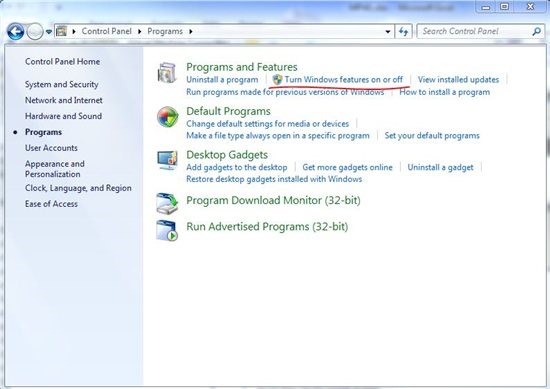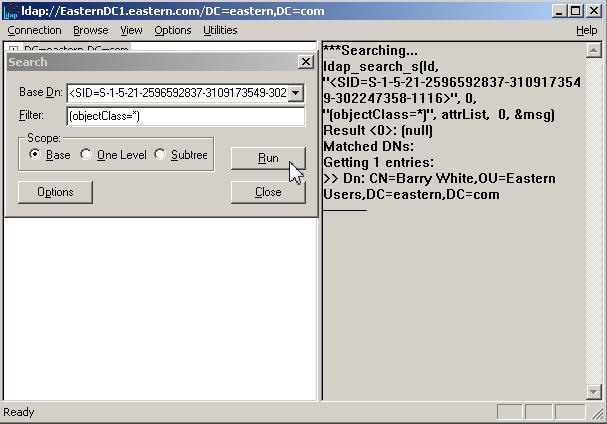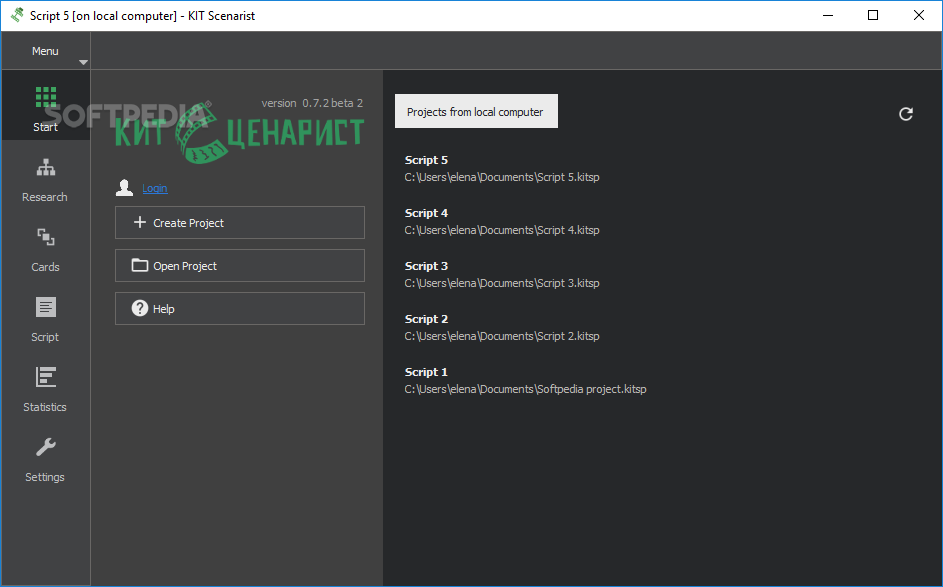Ldp Exe Microsoft Windows 7
Windows Server Server LDP.exeLDP is the forgotten tool in the Windows Server toolkit. Here on this page is a step-by-step tutorial for getting started with LDP. In my opinion, it should be called not LDP but LDAP, as that’s what it configures. Perhaps LDP is overlooked because it’s so hard to get going, I will reveal the secrets of how you search for Active Directory information with this Microsoft utility. Topics for Windows LDP.exe.‡Installing LDP is easy. From the CD supporttools, double click suptools.msi.
- Test Ldap Connection
- Windows Support Tools Ldp
- Ldp Exe Microsoft Windows 7 Free
- Ldp Exe Microsoft Windows 7 Download
Alternatively, here is a. There are a number of ways of executing ldp.exe, to begin with, let us call for the Run dialog box and type ldp.Scenario: We wish to view our domain and check on users whose first name begins with ‘a’.The more choices a program gives, the more difficult it is for a beginner to get started. In the case of LDP, you have to perform three operations in sequence before you can start.1) Click on the Connection menu, then Connect, select your server name.
Being an LDAP program, leave the port on 389. You don’t want C onnectionless, therefore leave the default setting. No tick in the Connectionless box. No need for SSL either.2) Next we need to Bind, which is rather like logging on. Even though you would expect that LDP would use the credentials of the logged on user, it does not always work that way.
Microsoft Ldp Download
Download Windows 7 Setup Exe
So just Bind with an Administrator’s name and password.3) Click View and select Tree; what you see is a box waiting for baseDN (Distinguished Name).Now we come to the crucial step. The text books say type, DC=yourdomain,DC=com. The problem comes if you are unsure of your domain name.
Microsoft Ldp Download Download Windows 7 Setup Exe Windows Server Server LDP.exeLDP is the forgotten tool in the Windows Server toolkit. Here on this page is a step-by-step tutorial for getting sta.
For instance, does it have an extension of.com? Guy says just try pressing OK without entering anything at all in the box.If it truly is your intention to connect to a domain, then do not use the drop-down menu and select, DC=ForestDnsZones,DC=domain,DC=com, that just does not work for me.4) What I hope you will see in the left hand LDP panel is a structure that reminds you of Active Directory Users and Computers.5) Now you have done all the hard work. It’s time for the first LDAP query. Click on the Browse menu, and select Search. Leave the Base Dn: dialog entry as it is, in the Filter box type (givenName=a.). If you remember our brief was to find all users whose first name begins with ‘A’.
If that produces no results, try (cn=a.). CN means common name, and surely there will be an administrators’ account in the domain?6) The fruits of all your LDP efforts should now appear in the right hand menu. The fact that the latest entries are at the bottom rather than the top, takes a little getting used to, so be prepared to scroll down.Guy Recommends 3 Free Active Directory ToolsSolarWinds have produced three Active Directory add-ons. These free utilities have been approved by Microsoft, and will help to manage your domain by:. Seeking and zapping unwanted user accounts. Finding inactive computers.
- Ldp is a graphical user interface (GUI)-based, Windows Explorer–like tool with a scope pane on the left that is used for navigating through the Active Directory namespace, and a details pane on the right that is used for displaying the results of the LDAP operations.
- Login to a Microsoft Windows local computer with a user account that has local Administrative privilege to perform the steps on this document. Note: If you do not currently have ldp.exe available on your system, you must first download the Windows Support Tools. This is available on the Microsoft website.
Bulk-importing new users. Give this AD utility a try, it’s free!
Method 2 – LDP.exe utility: Ldp is a graphical user interface (GUI)-based tool with a scope pane on the left that is used for navigating through the Active Directory namespace, and a details pane on the right that is used for displaying the results of the LDAP operations. LDP lets you perform connect, bind, search, modify, add or delete. Scroll down to the Windows Modules Installer service and double-click on it. Under Service status, click Stop. Use File Explorer to go to C: Windows Logs CBS.
.AD LDS is a Lightweight Directory Access Protocol (LDAP) directory service that provides flexible support for directory-enabled applications, without the dependencies that are required for Active Directory Domain Services (AD DS). AD LDS provides much of the same functionality as AD DS, but it does not require the deployment of domains or domain controllers. In environments where AD DS exists, AD LDS can use AD DS for the authentication of Windows security principals.
You can run multiple instances of AD LDS concurrently on a single computer, and have an independently managed schema for each AD LDS instance.
Windows Server Server LDP.exe
LDP is the forgotten tool in the Windows Server toolkit. Here on this page is a step-by-step tutorial for getting started with LDP. In my opinion, it should be called not LDP but LDAP, as that’s what it configures. Perhaps LDP is overlooked because it’s so hard to get going, I will reveal the secrets of how you search for Active Directory information with this Microsoft utility.
Topics for Windows LDP.exe
‡
Getting Started With Windows LDP
Installing LDP is easy. From the CD supporttools, double click suptools.msi. Alternatively, here is a free download of Microsoft’s LDP. There are a number of ways of executing ldp.exe, to begin with, let us call for the Run dialog box and type ldp.
Scenario: We wish to view our domain and check on users whose first name begins with ‘a’.
The more choices a program gives, the more difficult it is for a beginner to get started. In the case of LDP, you have to perform three operations in sequence before you can start.

1) Click on the Connection menu, then Connect, select your server name. Being an LDAP program, leave the port on 389. You don’t want Connectionless, therefore leave the default setting. No tick in the Connectionless box. No need for SSL either.
2) Next we need to Bind, which is rather like logging on. Even though you would expect that LDP would use the credentials of the logged on user, it does not always work that way. So just Bind with an Administrator’s name and password.
3) Click View and select Tree; what you see is a box waiting for baseDN (Distinguished Name).
Now we come to the crucial step. The text books say type, DC=yourdomain,DC=com. The problem comes if you are unsure of your domain name. For instance, does it have an extension of .com? Guy says just try pressing OK without entering anything at all in the box.
If it truly is your intention to connect to a domain, then do not use the drop-down menu and select, DC=ForestDnsZones,DC=domain,DC=com, that just does not work for me.
4) What I hope you will see in the left hand LDP panel is a structure that reminds you of Active Directory Users and Computers.
5) Now you have done all the hard work. It’s time for the first LDAP query. Click on the Browse menu, and select Search. Leave the Base Dn: dialog entry as it is, in the Filter box type (givenName=a*). If you remember our brief was to find all users whose first name begins with ‘A’. If that produces no results, try (cn=a*). CN means common name, and surely there will be an administrators’ account in the domain?
6) The fruits of all your LDP efforts should now appear in the right hand menu. The fact that the latest entries are at the bottom rather than the top, takes a little getting used to, so be prepared to scroll down.

Download Windows LDP.exe 64-bit

Guy Recommends 3 Free Active Directory Tools
SolarWinds have produced three Active Directory add-ons. These free utilities have been approved by Microsoft, and will help to manage your domain by:
- Seeking and zapping unwanted user accounts.
- Finding inactive computers.
- Bulk-importing new users. Give this AD utility a try, it’s free!
Test Ldap Connection
An Example of An LDP Printout
***Searching…
ldap_search_s(ld, 'DC=cp,DC=com', 2, '(cn=a*)', attrList, 0, &msg)
Result <0>: (null)
Matched DNs:
Getting 24 entries:
>> Dn: CN=a86fe12a-0f62-4e2a-b271-d27f601f8182,CN=Operations,CN=DomainUpdates,CN=System,DC=cp,DC=com
2> objectClass: top; container;
1> cn: a86fe12a-0f62-4e2a-b271-d27f601f8182;
1> distinguishedName: CN=a86fe12a-0f62-4e2a-b271-d27f601f8182,CN=Operations,CN=DomainUpdates,CN=System,DC=cp,DC=com;
1> name: a86fe12a-0f62-4e2a-b271-d27f601f8182;
1> canonicalName: cp.com/System/DomainUpdates/Operations/a86fe12a-0f62-4e2a-b271-d27f601f8182;
>> Dn: CN=ab402345-d3c3-455d-9ff7-40268a1099b6,CN=Operations,CN=DomainUpdates,CN=System,DC=cp,DC=com
2> objectClass: top; container;
1> cn: ab402345-d3c3-455d-9ff7-40268a1099b6;
1> distinguishedName: CN=ab402345-d3c3-455d-9ff7-40268a1099b6,CN=Operations,CN=DomainUpdates,CN=System,DC=cp,DC=com;
1> name: ab402345-d3c3-455d-9ff7-40268a1099b6;
1> canonicalName: cp.com/System/DomainUpdates/Operations/ab402345-d3c3-455d-9ff7-40268a1099b6;
>> Dn: CN=ab9b6f9e-7ef4-4e9a-902d-ae9a3881bce9,CN=Packages,CN=Class Store,CN=Machine,CN={4627307D-103B-4A81-99D0-B5B06B8AD999},CN=Policies,CN=System,DC=cp,DC=com
2> objectClass: top; packageRegistration;
1> cn: ab9b6f9e-7ef4-4e9a-902d-ae9a3881bce9;
1> distinguishedName: CN=ab9b6f9e-7ef4-4e9a-902d-ae9a3881bce9,CN=Packages,CN=Class Store,CN=Machine,CN={4627307D-103B-4A81-99D0-B5B06B8AD999},CN=Policies,CN=System,DC=cp,DC=com;
1> name: ab9b6f9e-7ef4-4e9a-902d-ae9a3881bce9;
1> canonicalName: cp.com/System/Policies/{4627307D-103B-4A81-99D0-B5B06B8AD999}/Machine/Class Store/Packages/ab9b6f9e-7ef4-4e9a-902d-ae9a3881bce9;
>> Dn: CN=abab2104-5729-4bed-ac94-a65c89516e84,CN=AppCategories,CN=Default Domain Policy,CN=System,DC=cp,DC=com
3> objectClass: top; leaf; categoryRegistration;
1> cn: abab2104-5729-4bed-ac94-a65c89516e84;
1> distinguishedName: CN=abab2104-5729-4bed-ac94-a65c89516e84,CN=AppCategories,CN=Default Domain Policy,CN=System,DC=cp,DC=com;
1> name: abab2104-5729-4bed-ac94-a65c89516e84;
1> canonicalName: cp.com/System/Default Domain Policy/AppCategories/abab2104-5729-4bed-ac94-a65c89516e84;
>> Dn: CN=Account Operators,CN=Builtin,DC=cp,DC=com
2> objectClass: top; group;
1> cn: Account Operators;
1> description: Members can administer domain user and group accounts;
1> distinguishedName: CN=Account Operators,CN=Builtin,DC=cp,DC=com;
1> name: Account Operators;
1> canonicalName: cp.com/Builtin/Account Operators;
>> Dn: CN=Administrator,CN=Users,DC=cp,DC=com
4> objectClass: top; person; organizationalPerson; user;
1> cn: Administrator;
1> description: Built-in account for administering the computer/domain;
1> distinguishedName: CN=Administrator,CN=Users,DC=cp,DC=com;
1> name: Administrator;
1> canonicalName: cp.com/Users/Administrator;
>> Dn: CN=Administrators,CN=Builtin,DC=cp,DC=com
2> objectClass: top; group;
1> cn: Administrators;
1> description: Administrators have complete and unrestricted access to the computer/domain;
1> distinguishedName: CN=Administrators,CN=Builtin,DC=cp,DC=com;
1> name: Administrators;
1> canonicalName: cp.com/Builtin/Administrators;
Guy Recommends: Permissions Analyzer – Free Active Directory Tool
I like thePermissions Monitor because it enables me to see quickly WHO has permissions to do WHAT. When you launch this tool it analyzes a users effective NTFS permissions for a specific file or folder, takes into account network share access, then displays the results in a nifty desktop dashboard!
Think of all the frustration that this free utility saves when you are troubleshooting authorization problems for users access to a resource. Give this permissions monitor a try – it’s free!
Summary of LDP
Microsoft’s LDP is a tricky program to get started. This page gives you a step-by-step tutorial to create LDAP queries against a Windows Server Active Directory. Get your copy of LDP from the Windows Server Support Tools.
Windows Support Tools Ldp

If you like this page then please share it with your friends
Microsoft Windows Server 2008 Topics:
• Server 2008 Home • Overview • What’s New? • Server Manager • Install
Ldp Exe Microsoft Windows 7 Free
• Hyper-V • Windows LDP.exe download • Group Policy • Remote restart Windows server
Ldp Exe Microsoft Windows 7 Download
• Network Performance Monitor • Windows Server 2012 • SP1 Review • IPAM 3 Review